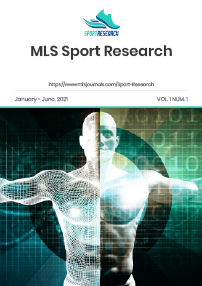Volume 1 Issue 1 (2021)
Published 2021-04-28
Full Issue
The use of the Foam Roller (FR) is a relatively new myofascial release technique that is experiencing a considerable increase in the sport and health environment. The aim of this study was to compare the various types of FR by assessing their acute effect on the rectus femoris (RF) muscle using Tensiomyography (TMG), taking into account the variables Maximum Deformation (Dm) and Contraction Time (Tc). Ten participants from the Faculty of Physical Activity and Sport Sciences (CAFYD) carried out the study with one type of RF each session, spread over three days. Each subject performed 3 sets of 90 seconds with 30 seconds rest, on the dominant leg only. The TMG measurements were two, before and after the use of the RF. When analysing the effects produced by all the RF on the total number of participants, no significant differences were found in any of the variables. Although we noticed that, when separating the sample by level of sporting activity, the FR Hard (FRD) and FR Relieve (FRR) caused a significant decrease in Tc, causing activation in the Untrained Subjects (SNE). On the contrary, in the Trained Subjects (TS), the effect of FRD produced an increase in Tc, causing a relaxation of RF. The variations become noticeable depending on the sport practice and probably on the muscle tone. Therefore, the user's physical shape and experience with the Foam Roller must be taken into account, as this will directly influence the effect of its use.
Researches based on motivation and self-compassion has shown that they are personal characteristics which influence the development of each individual. The aim of the present study is to analyse the evolution of motivation and self-compassion throughout a complete sport season, in order to assess if there are differences between its periods taking into account each sport. The research involved 48 athletes (42 men and 6 women) between the ages of 15 and 53 (average = 23.5) who played soccer (29.2%), athletics (31.3%) or rugby (39, 6%) in the Autonomous Community of Cantabria. They answered two tests: a motivational questionnaire (BRSQ) and a self-compassion scale. The results obtained showed that both variables remain unchangeable throughout the season if the analysis is carried out in a general manner. On the other hand, if sports are compared to each other, statistically significant differences were found in most of the motivation variables, which implies that this is influenced by the sport that is practiced. In the case of self-compassion, only the Mindfulness variable had significance, so it is also subject to the influence of the different characteristics of each sport.
The aim of this review was to find out the effects of different dance programmes on the improvement of symptoms and quality of life in patients with Parkinson's disease (PD). A systematic review of different dance programmes was carried out in three databases (Google Scholar, Pubmed and Dialnet). We included 14 trials with a total of 469 participants and evaluated different dance modalities, which showed favourable results on motor function, cognitive function and quality of life in people with PD. The modality of tango, followed by samba, seems to be the most suitable for this type of disease, producing greater improvements in balance, speed of movement and gait pattern, due to its variety of movements and characteristic marked rhythm. However, the two most challenging dances were the waltz and the cha-cha-cha, due to the crossing of the feet, changes of direction and less grip. Although there is a need for continued research and longer programmes, the analysis of results suggests that dancing can be an effective treatment for PD patients, as there is a decrease in symptoms and therefore an improvement in quality of life.
Primary dysmenorrhea (PD) is the most common menstrual disorder and is defined as painful menstruation. This health problem reduces the quality of life of more than 70% of women who suffer from it, so the main objectives of this review were to assess whether physical exercise was safe for these women and, knowing its effects on PD, compare the different exercises or training methods by analyzing which are the most effective. In this paper, articles from the PubMed database were reviewed, selecting those written in Spanish and English that were no more than 5 years old and choosing intervention studies to perform the analysis. In addition, the information was completed with the website of The American College of Obstetricians and Gynecologists. Interventions pointed to physical exercise as a positive treatment for PD. The most significant improvements were obtained in the pain and intensity of menstruation. There were also reductions in menstrual distress, duration of pain and painkillers consumed, as well as improvements in quality of life. It is concluded that regular physical exercise is a safe and effective method to reduce the symptoms caused by PD. Long-term exercise will also have beneficial effects in the long run, further reducing these symptoms and improving the overall health of the person. In addition, it should be noted that this treatment does not generate side effects in the body. Aerobic exercise seems to be the most effective training method for dysmenorrhea symptoms, followed by some stretching exercises or yoga.
The main objectives of this research were to analyze the effects of the different phases of the menstrual cycle (MC) on two elements of the physical condition, strength-power and dynamic balance, and on the psychological state of a moderately active woman. A 28-year-old woman participated in this study, who used oral contraceptives. In total, 6 sessions were recorded, corresponding to 2 complete menstrual cycles and each of its phases (menstrual, follicular and luteal). In each session, three tests were carried out to evaluate the physical condition variables (Leg extension in Kineo, Press Bench in Multipower and Y Balance Test) and a test for psychological variables (POMS Test). The results obtained showed that during the luteal phase the participant achieved the lowest values in the 3 physical tests of power and dynamic balance, being the follicular phase (FP) where she obtained the best performance. In the psychological test, the menstrual phase (MP) stands out for having the highest values in the fatigue-inertia dimension, in contrast to the FP where higher values were observed for the vigor-activation dimensión. The personal questionnaire on MC revealed the presence of menstrual and premenstrual symptoms in the two cycles studied. It is suggested that the changes produced in the physical and psychological variables of the subject are due to the presence of premenstrual symptoms, without being able to confirm the hormonal influence as blood or urine tests have not been performed.
Introduction: The rupture of the Anterior Cruciate Ligament (ACL) is one of the most problematic injuries in the world of football, not only because of the period that it will keep the subject inactive, but also because of the consequences that it can produce in the athlete. Objectives: To know some of the risk factors, as well as the mechanism of ACL injuries in the last three seasons in Cantabrian football. Material and methods: Data was collected on different risk factors of all ACL injured Cantabrian soccer players in the last 3 seasons (2016 to 2019). These data were recorded through an interview conducted by the Cantabrian Football Federation. The initial sample was 93 people, 84 being men (H) and 9 women (M). Results: The competition turned out to be more harmful than the training (H: 88.5%; M: 77.8%), being the first part of the match where there were more injuries (H: 47.8%; M: 66.7 %). Defenders in men (50.7%) and midfielders in women (55.6%) were the most affected positions. With 87% in men and 100% in women, the injuries occurred on artificial grass with the use of Artificial Grass (AG) studs (H: 46.4%; M: 77.8%) and during the month of April (H: 4.5%; M: 33.3%). In addition, the injuries occurred without contact (H: 73.9%; M: 77.8%) and 66.7% in both groups did not perform preventive work. Conclusions: ACL injury occurs mainly without contact, with the use of AG cleats on artificial turf, during the first part of the game and in April. Defenders in men and midfielders in women were the most affected positions.













